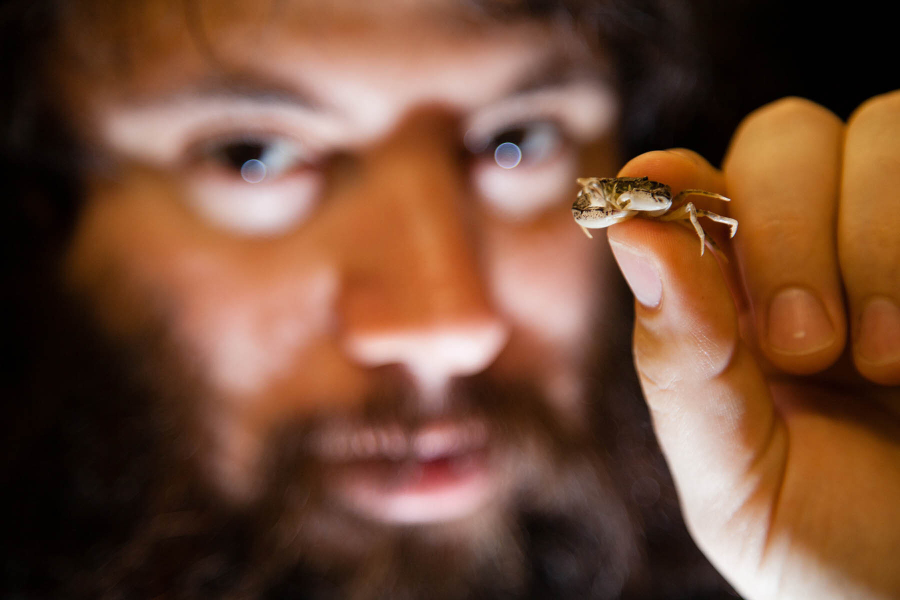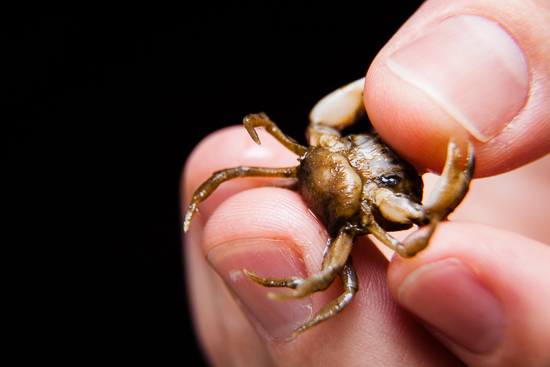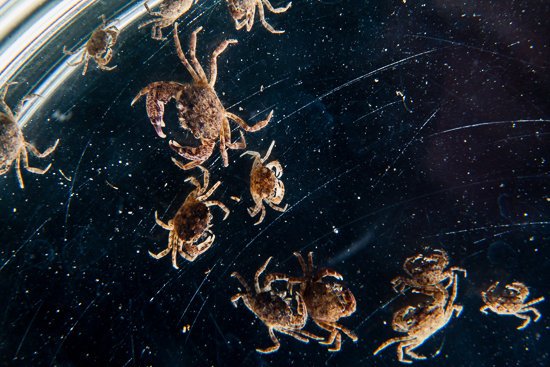'Zombie' crabs invade the Chesapeake Bay
Invasive parasite takes control of native black-fingered mud crabs, affecting motor function and reproduction

Imagine you are going about your day as usual when you encounter a foreign creature. It injects something in you, but does not kill you. Over the next few weeks, you notice a growth in your abdomen. A network of tube-like threads spreads throughout your circulatory system. Soon, you start losing control of your motor functions. You adopt defensive postures and develop maternal instincts to care for the growth instead of caring for yourself. Then, the mass begins to expel larvae, which seek out and infect anyone nearby. Your behavior is forever changed and your reproductive system destroyed.
This scenario may seem like something out of a science fiction novel or the latest zombie thriller. But for many black-fingered mud crabs, the parasite Loxothylacus panopaei, or loxo, has made this situation a reality.
Loxo was discovered in the Chesapeake Bay about 50 years ago. Scientists believe it was carried from its native range in the Gulf of Mexico on oyster shells during early restoration efforts. Since then, researchers have found sites throughout the Bay where the parasite is highly prevalent, with infection rates as high as 30 to 50 percent.

“This is huge, especially because this parasite is a castrator, so infecting crabs means they can no longer reproduce,” said Carolyn Tepolt, Biodiversity Genomics Postdoctoral Fellow at the Smithsonian Institute. “[The crabs] are still alive, but essentially dead as far as genes are concerned, because they are not contributing to the next generation of crabs.”
The Chesapeake Bay Parasite Project was established as a means for scientists to develop a better understanding of loxo by both monitoring infection rates in the wild and making observations in a lab, where research can be done in a controlled environment.

“In 2013, I had the idea that it should be a citizen science project,” said Monaca Noble, Biologist at the Smithsonian Institute. “This isn’t a project that has its own grant money. It’s a project we do because we love it, so it’s always collateral duty for somebody. We thought it would be great to bring on volunteers.”
Through studying the prevalence of the parasite in both its native and invasive range, researchers now understand that loxo is much rarer along the Gulf Coast and up to Cape Canaveral, Fla., where one to five percent of crabs are infected. Tepolt and her colleagues are working to understand if reproductive pressures have affected these numbers over generations. “Say you’re a crab and you have some little mutation that makes it a little harder for the parasite to infect you, you may have a huge evolutionary advantage if 50 percent of your peers are getting taken out of the gene pool,” said Tepolt.

Citizen science has proven to be a valuable method for studying loxo’s reach and the population of affected crabs. Noble and her team have seen a steady increase in volunteer numbers, with 89 participants this past summer compared to 50 in 2014.
“I love [The Chesapeake Bay Parasite Project] as a citizen science project,” explained Noble. “It’s an opportunity to share an exciting story about science with people who are interested and get them excited about science, and also tell them about invasive species.”
To view more photos, visit the Chesapeake Bay Program’s Flickr page.
Text by Jenna Valente
Images by Will Parson

Comments
There is no reason to be concerned! The parasites won't turn humans into zombies if they are eaten by accident, but rather the human body will digest them normally.
let's say a human ate one of these crabs, would we get infected with this virus or get a stomach bug?
Hi Jim, Great question! It sounds like what you encountered were "pea crabs," small crabs that live as a parasites in oysters, clams, mussels, and other bivalves. Some people consider these pea crabs a delicacy and will purposefully seek them out to eat!
I remember seeing what looked like these crabs at a Clam Bake on the beach in Nantucket Island. Virtually every steamed clam had at least one of these small crabs inside them when we opened them. Since they were cooked, they were quite tasty, but crunchy and unexpected. This was like 15-20 years ago, would they have been the same invasive crabs? Thanks.
Thank you!
Your comment has been received. Before it can be published, the comment will be reviewed by our team to ensure it adheres with our rules of engagement.
Back to recent stories